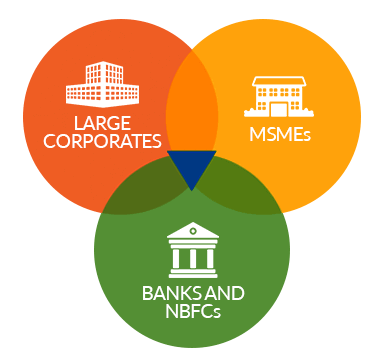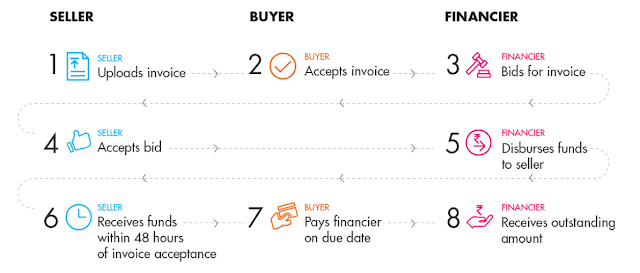Commercial Blockchain application in mainstream commerce - An India Example
I have been a supporter of Blockchain technology (the keypin of crypto currencies) for long time now. I had blogged about the utility of secure open-ledger transactions here and here. Blockchain applications can be extended to virtually a lot of fields and international trade is one of them. India is at decent level of technology application when it comes to blockchains, as opposed to the shoddy levels we display when it comes to AI and machine learning applications in public policy sphere.
To cite a good example of blockchain application in mainstream commerce, we can look at the Trade Receivable Discounting System (TReDS) guidelines of RBI, which sought to set up a system to ease the liquidity crunch for MSMEs by way of bill/invoice factoring in the financial market for the supplies made to big corporates.
To cite a good example of blockchain application in mainstream commerce, we can look at the Trade Receivable Discounting System (TReDS) guidelines of RBI, which sought to set up a system to ease the liquidity crunch for MSMEs by way of bill/invoice factoring in the financial market for the supplies made to big corporates.
I shall briefly explain the simplified process under TReDS with an example (or see image below). Let's assume Mismi enterprise, which is an MSME, supplies items to Bigcor, a corporate house. Usually Bigcor takes three months to settle the payments after the delivery of goods. This holds up Mismi's working capital for three months leading to liquidity cruch for Mismi. Mismi's efforts to convicne Bigcor to make earlier payments doesn't work as Bigcor has market power to dictate terms to Mismi and other such suppliers. With the advent of TReDS, Mismi uploads the digitally signed invoice on one of the three platforms currently approved by RBI. The upload is done after the supplies are made to Bigcor. Bigcor gets a time window (say of 2 days) to approve the invoice online, thus verifying the authenticity of the supply and the commitment that it would pay the sum against the invoice raised within three month (or agreed time frame). The approved invoice can now be factored on the platform, through auction, by the financial intermediaries like Banks/NBFCs. For example, BigBank may buy the inovice at a discount and pay the money to Mismi, thus ending the liquidity crunch immediately. The actual payment would be realized by the BigBank after three months from Bigcor. In an ideal competitive marketplace the discount should equal the interest cost for three months + nominal service charges. Registration on TReDS has been made mandatory for the public sector enterprises by the government. As public sector is a big ticket buyer for a large number of MSMEs, it is expected that a critical mass would be easily obtained by the system to start rolling. The three platforms are already active. They are RXIL, M1xchange and A.TReDS.
When the system was initially set up, there were apprehensions that the big corporate bodies were uncomfortable with the identities of their suppliers being revealed online. Now the platforms have come up with the solution that includes the blockchain. I see two clear advantages of using blockchain technology in such a situation. First, maintaining anonymity of invoice raiser is possible. Second, cross trading across multiple platforms is possible without the fear of double invoicing. It makes the entire chain secure, anonymous, and verifiable at the same time, in a way the simple digital key encryption cannot.
As TReDS is one of the early examples of implementation of Blockchain in real commerce, I see this as heralding an era of trade facilitation through e contracts, secure e waybills, secure letters of credit, bills of lading, international factoring and forfaiting services and so on. In fact, I don’t see a reason as to why the entire paper based international trade transactions including title of goods (currently the paper bill of lading) shouldn’t be moved onto something based on blockchains which are maintained through peer to peer open ledger platforms.
This would need two further institutional arrangements to be put in place:
A) International arrangement to give sanctity to these transactions through common agreement or laws
B) Infrastructure support to develop and maintain the basic structure of the transactions or the marketplaces - either through private parties or through a multinational consortium.
While A can be integrated with the trade facilitation efforts in the next stage at WTO, and through efforts at making model laws and best practices at UNCITRAL/UNCTAD, part B has to be a joint or multilateral effort by the leaders in the field. Both are doable. The technology is there. We need to gather the will to push it. Probably India might be a leader if we take the initiative. It can indeed be a 21st century issue that India might like to discuss.
As TReDS is one of the early examples of implementation of Blockchain in real commerce, I see this as heralding an era of trade facilitation through e contracts, secure e waybills, secure letters of credit, bills of lading, international factoring and forfaiting services and so on. In fact, I don’t see a reason as to why the entire paper based international trade transactions including title of goods (currently the paper bill of lading) shouldn’t be moved onto something based on blockchains which are maintained through peer to peer open ledger platforms.
This would need two further institutional arrangements to be put in place:
A) International arrangement to give sanctity to these transactions through common agreement or laws
B) Infrastructure support to develop and maintain the basic structure of the transactions or the marketplaces - either through private parties or through a multinational consortium.
While A can be integrated with the trade facilitation efforts in the next stage at WTO, and through efforts at making model laws and best practices at UNCITRAL/UNCTAD, part B has to be a joint or multilateral effort by the leaders in the field. Both are doable. The technology is there. We need to gather the will to push it. Probably India might be a leader if we take the initiative. It can indeed be a 21st century issue that India might like to discuss.


Comments
Post a Comment
Comments are moderated. Your comment will be online shortly. Kindly excuse the lag